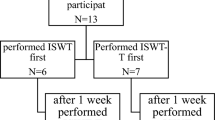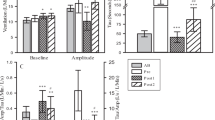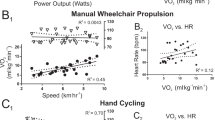Abstract
Study design:
Determination of differences in the cardiorespiratory responses of tetraplegic subjects with incomplete and complete lesions during treadmill gait and endurance exercise provided by neuromuscular electrical stimulation (NMES). Differences between rest and exercise phases were also examined.
Objectives:
To compare the cardiorespiratory responses in tetraplegic individuals during endurance exercise in the sitting position and treadmill gait with 30–50% body weight relief, both provided by NMES.
Setting:
Rehabilitation Ambulatory at University Hospital, Brazil.
Methods:
A total of 31 tetraplegic subjects were evaluated. Individuals were separated into two groups: gait group and endurance exercise group. In the gait group (n=17), the exercise protocol consisted of three different phases: 8 min of rest, 10 min of treadmill walking using NMES and 10 min of recovery. In the endurance exercise group (n=14), the cardiorespiratory test consisted of 8 min of rest, 15 min of quadriceps endurance exercise in the sitting position by NMES and 10 min of recovery. Oxygen uptake (VO2), carbon dioxide production (VCO2), respiratory exchange ratio (RER), pulmonary ventilation (VE) and heart rate (HR) were measured.
Results:
All parameters increased considerably in the gait group from rest to the walking phase, although individuals with incomplete lesions presented a more pronounced increase than those with complete lesion. In the gait group, for incomplete tetraplegics, the mean VO2 peak was 0.816±0.314 l/min, corresponding to 11.41±3.11 ml/kg/min; the mean value for VCO2 was 0.660±0.24 l/min, mean HR was 124.54±28.72 bpm and mean VE was 28.38±6.28 l/min. In the endurance exercise group, for incomplete tetraplegics, the mean VO2 peak was 0.246±0.07 l/min, corresponding to 3.84±0.92 ml/kg/min; the mean value for VCO2 was 0.205±0.06 l/min, mean HR was 71.45±15.51 bpm and mean VE was 11.83±2.72 l/min. In the endurance exercise group, smaller differences were observed in all variables from rest to the exercise phase, compared with the large increases observed in the gait group.
Conclusions:
These preliminary results have shown that gait training probably improves physical capacity in tetraplegic individuals more than the endurance exercise.
Similar content being viewed by others
Introduction
Tetraplegic subjects present a low physical capacity, due to extensive muscle mass paralysis, sympathetic autonomic impairment and decreased venous return, resulting in diminished responses of heart rate, cardiac output and oxygen uptake (VO2).1 Lower physical activity associated with significant bone loss, skeletal muscle atrophy, increase of body fat and decrease of lean body mass are responsible for physical deconditioning.2 Training, which improves the physical performance in spinal cord injured subjects, increases the ability to perform daily activities and reduces medical complications.
Neuromuscular electrical stimulation (NMES) in spinal cord injured subjects allows the activation of paralyzed muscles through electrical stimulation of intact periphery motoneurons.3 Thus, NMES has been used extensively in order to provide walking function4 and to study the action of the spinal cord in the control of movement, using the concept of task-oriented training, which suggests that sensory input can produce the basic motor pattern.5 Gait training on the treadmill provides a constant rate of movement and rhythm, which stimulates the reciprocal coordination of the lower limbs.6
Moreover, NMES activates the large muscle mass, increases strength and muscle endurance, stimulates the leg muscle venous pump, facilitates venous return, increases cardiac preload and stroke volume through the Frank–Starling mechanism, improving the cardiac output.1 Thus, it promotes an increase of cardiovascular stress, which stimulates cardiovascular adaptations and, consequently, improves the physical capacity in persons with spinal cord injuries.
Body weight support (BWS) has been used in order to facilitate and provide appropriate gait because it assists the stance cycle of gait, allows weight relief that can be supported by the lower limbs of each patient and assists trunk stabilization. Moreover, this tool reduces the risk of post-traumatic syringomyelia and fracture in osteoporotic bones.5
The purpose of the present study was to evaluate the cardiorespiratory responses in tetraplegic individuals during treadmill walking induced by NMES, assisted by partial BWS and to compare them to endurance exercise of the lower limbs in the sitting position. The relationship between cardiopulmonary responses of complete and incomplete lesions was assessed.
Methods
A total of 31 tetraplegic subjects, all male (mean age 31.64±8.92 years), participated in this study. The lesion level varied between C4 and C8. A total of 19 individuals had a complete lesion. In the gait group (GG), five individuals had an incomplete lesion (ASIA Impairment Scale: B (n=2), C (n=2), D (n=1)) and 12 had a complete lesion. In the endurance exercise group (EExG), seven individuals had an incomplete lesion (ASIA Impairment Scale: B (n=6)) and seven individuals had a complete lesion. Median time postinjury was 62.25±43.34 months (range 17–180 months). Mean body mass and height of subjects were 65.54±11.18 kg and 177.45±7.45 cm, respectively. The study was approved by the local ethical committee. Inclusion criteria included intact lower motor neurons, which are required for muscle contraction using surface electrical stimulation and toward performing a walking capacity for treadmill gait, with 30–50% BWS during 10 min consecutively. Another requirement was no history of cardiopulmonary disease. All subjects had their quadriceps and tibialis anterior muscles stimulated for at least 5 months before the tests. All subjects belonged to the Spinal Cord Injuries’ Rehabilitation Ambulatory of the University Hospital. As individuals had different times of postinjury and, consequently, different degrees of muscle deterioration, each subject performed the prior muscle exercise with NMES. A four-channel electrical stimulator delivered a signal of 25 Hz with monophasic rectangular pulses with 300 μs duration and a maximum intensity of 200 V (1 kΩ load). Each patient was trained toward a minimum time (without visible muscle fatigue) of 15 min of knee extension under quadriceps stimulation (EExG). For the GG, all subjects had to be able (minimum requirement) to stand up for at least 10 min, as well as support 50% of their body weight through knee extension provided by NMES.
Individuals were separated into two groups: GG (n=17) and EExG (n=14). In the GG, before cardiorespiratory tests, three sessions of treadmill walking with NMES and BWS were allowed for each subject to become accustomed to the system. The exercise protocol consisted of three different phases: 8 min of rest, 10 min of treadmill walking and 10 min of recovery. In the EExG, the cardiorespiratory test consisted of 8 min of rest, 15 min of quadriceps endurance exercise in the sitting position by NMES and 10 min of recovery. Oxygen uptake (VO2), carbon dioxide production (VCO2), respiratory exchange ratio (RER) and pulmonary ventilation (VE) were measured by open-circuit spirometry (SensorMedics, Vmax 29c Cardiopulmonary Exercise Testing Instrument). Calibration was performed prior to each test with reference gases. Values were averaged over the last five 30-s periods for each phase. Heart rate (HR) was determined by electrocardiogram, which was continuously monitored.
BWS was provided by a harness suspended from an overhead support, and the support vest allowed free movement of the lower limbs. BWS was within 30 and 50%. A four-channel electrical stimulator was used to provide the stance gait phase via quadriceps muscle activation and the swing phase by the withdrawal reflex (stimuli to the common peroneal nerve). Manual assistance during treadmill walking was provided in patients who required it. Treadmill speed was kept constant at 0.5 km/h.
Due to the relatively small sample of each subgroup, data were analyzed to determine the percentage differences in physiological responses (VO2, VCO2, HR, VE) during rest and exercise phases for GG and EExG separately, and also for the comparison of these parameters between the two groups in the exercise phase. Tetraplegic persons with incomplete and complete lesions were analyzed separately. Results are presented as mean±standard deviation (SD) values.
Results
Table 1 presents the metabolic and cardiopulmonary results. Analyzed parameters from GG presented greater variation in patients with incomplete lesions when compared to complete ones. Thus, values of incomplete and complete lesions are shown separately. No great differences were observed between complete and incomplete lesions in subjects from EExG in any analyzed parameter.
During treadmill gait, in tetraplegic individuals with incomplete lesions, the mean VO2 peak was 0.816±0.314 l/min, VCO2 was 0.660±0.24 l/min, mean HR was 124.54±28.72 bpm and mean VE was 28.38±6.28 l/min. Comparisons of gait and rest phases showed an increase of 251.72% in VO2 l/min, 312.5% in VCO2, 58.50% in HR and 156.13% in VE. For individuals with complete lesions, the mean VO2 peak was 0.398±0.08 l/min, VCO2 was 0.325±0.06 l/min, mean HR was 103.38±17.96 bpm and mean VE was 18.39±2.38 l/min. Comparisons of gait and rest phases showed an increase of 130.05% in VO2 l/min, 166.39% in VCO2, 43.16% in HR and 81% in VE. Results have shown that all parameters increased considerably from rest to treadmill gait. Moreover, complete and incomplete tetraplegics have not shown much difference at rest (between the values for VO2 l/min, the difference was 34.10%, for VCO2 it was 31.14%, for HR it was 8.79% and for VE it was 9.05%) but, during gait incomplete, patients presented higher values for all parameters, mainly VO2 l/min (105.02% higher) and VCO2 (103.07% higher). HR was 20.44% and VE was 54.32% higher in incomplete subjects when compared to complete ones.
During endurance exercise, in tetraplegic individuals with incomplete lesions, the mean VO2 peak was 0.246±0.07 l/min, mean VCO2 was 0.205±0.06 l/min, mean HR was 71.45±15.51 bpm and mean VE was 11.83±2.72 l/min. Results showed an increase of 41.38% in VO2 l/min, 47.48% in VCO2 and 26.93% in VE when comparing rest and exercise phases. In individuals with complete lesions, the mean VO2 peak was 0.251±0.11, mean VCO2 was 0.204±0.09 l/min, mean HR was 78.41±18.32 bpm and mean VE was 11.33±2.18 l/min. Results showed an increase of 64.05% in VO2 l/min, 90.65% in VCO2, 6.59% in HR and 26.59% in VE when comparing rest phase and exercise phase. However, no great differences were found when comparing subjects with complete and incomplete lesions. In the EExG, the increase was dramatically lower than that observed from rest to exercise phase in the treadmill GG.
Incomplete tetraplegic subjects presented higher values during gait than those of endurance exercise (231% higher for VO2 l/min, 221.95% higher for VCO2, 74.27% higher for HR and 139.89% higher for VE). Individuals with complete lesions during gait presented higher values than those of endurance exercise, but in a smaller proportion (VO2 l/min=58.56% higher; VCO2=59.31% higher; VE=62.31% higher and HR=31.84% higher). Figure 1 compares VO2 and HR patterns obtained during treadmill gait in incomplete and complete patients. Figure 2 compares VO2 and HR patterns obtained during endurance exercise for incomplete and complete patients. Data for VO2, VCO2, RER, VE and HR are illustrated in Figure 3a–f.
Respiratory responses of tetraplegic subjects with incomplete (I) and complete (C) lesions at rest and during endurance exercise or treadmill gait (values are mean±SD): (a) oxygen uptake (VO2, ml/kg/min); (b) oxygen uptake (VO2, l/min); (c) carbon dioxide production (VCO2, l/min); (d) pulmonary ventilation (VE, l/min); (e) respiratory exchange ratio: RER, VCO2/VO2); (f) Heart rate (HR, bpm). EExG: endurance exercise group; GG: gait group; ▓ EExG; ▒ GG
Discussion
Results have shown that tetraplegic persons with incomplete lesions presented an increased functional capacity when compared to complete lesions. However, this difference could just be noted when individuals performed treadmill gait, probably due to the fact that gait requires higher activity from the cardiovascular system.
Sympathetic nervous system (SNS) during exercise provides vasoconstrictor responses, which increase venous return, heart rate response and cardiac output. Cervical complete lesion results in reduced SNS efferent activity below the lesion level, thus negatively affecting the cardiac performance.7, 8 Individuals with an incomplete lesion can present some degree of SNS activity, which contributes to better cardiovascular responses during gait exercise, associated to the presence of more functioning muscles.
The VO2 level depends on the stroke volume, which increases the O2 delivery to the exercising muscles, and the capability to consume O2 by skeletal muscles.9, 10
Thus, NMES is a useful tool to improve the cardiopulmonary responses in individuals with spinal cord injuries and consequently provides both central (cardiorespiratory system) and peripheral adaptations (muscle changes). NMES reduces the peripheral limitations to exercise due to the recruitment of a large lower muscle mass and reactivates the leg muscle pump. The higher the venous return, the higher the cardiac preload and cardiac output through the Frank–Starling mechanism. In addition, the activation of paralyzed muscles increases the oxygen extraction, interfering in VO2 values. The prolonged use of NMES improves the muscular strength and endurance capacity.9, 11
The moderate increase in heart rate observed during treadmill gait in complete compared to incomplete tetraplegics occurs probably due to parasympathetic vagal withdrawal and not due to sympathetic activity. This heart rate pattern was also observed by Eriksson et al,12 who studied the physiological responses in tetraplegic individuals during maximal wheelchair exercise and obtained the mean heart rate of 119 bpm for untrained and 118 bpm for trained persons with complete lesions, and 138 bpm for incomplete tetraplegic subjects.
Also, the results have shown a correlation between VE and VO2 during endurance exercise and gait, thus reflecting the contribution of pulmonary ventilation to achieve different levels of VO2, since tetraplegic subjects can have some paralyzed respiratory muscles.12, 13
Conclusions
These preliminary results indicate that both exercises are capable of increasing the analyzed parameters. However, gait training compared to endurance exercise seems to be more efficient in order to stimulate cardiorespiratory adaptations. Moreover, during treadmill gait, there were great differences between complete and incomplete lesions, not observed during endurance exercise. These results indicate that despite the autonomic sympathetic deficiencies and extensive muscle paralyses, gait can improve the metabolic (VO2) and cardiopulmonary (HR, ventilation) responses in tetraplegic individuals.
References
Dallmeijer AJ, Hopman MTE, van As HHJ, van der Woude LHV . Physical capacity and physical strain in persons with tetraplegia: the role of sports activity. Spinal Cord 1996; 34: 728–735.
Figoni SF . Exercise responses and quadriplegia. Med Sci Sports Exerc 1993; 25: 433–441.
Cliquet Jr A, Baxendale RH, Andrews BJ . Paraplegic locomotion and its metabolic energy expenditure. In: Rose FC, Jones R, Vrborá G (eds). Comprehensive Neurologic Rehabilitation, Vol. 3 – Neuromuscular Stimulation: Basic Concepts and Clinical Implications. EUA: New York 1989, pp 139–146.
Cliquet Jr A, Solomonidis SE, Andrews BJ, Paul JP . Fes in Standing up Paralyzed Person – A Biomechanical Assessment. Clinical Applications of Biomechanics. Biological Engineering Society, University of Salford: GB 1988.
Field-Fote EC . Combined use of body weight support, functional electric stimulation, and treadmill training to improve walking ability in individuals with chronic incomplete spinal cord injury. Arch Phys Med Rehabil 2001; 82: 818–824.
Abel R, Schablowski M, Rupp R, Gerner HJ . Gait analysis on the treadmill – monitoring exercise in the treatment of paraplegia. Spinal Cord 2002; 40: 17–22.
McLean KP, Jones PP, Skiner JS . Exercise prescription for sitting and supine exercise in subjects with quadriplegia. Med Sci Sports Exerc 1995; 27: 15–21.
Teasell RW, Arnold MO, Krassioukov A, Delaney GA . Cardiovascular consequences of loss of supraspinal control of the sympathetic nervous system after spinal cord injury. Arch Phys Med Rehabil 2000; 81: 506–516.
Faghri PD, Glaser RM, Figoni SF . Functional electrical stimulation leg cycle ergometer exercise: training effects on cardiorespiratory responses of spinal cord injured subjects at rest and during submaximal exercise. Arch Phys Med Rehabil 1992; 73: 1085–1093.
Foss ML, Keteyian SJ . Fox's Physiological Basis for Exercise and Sport, (6th edn.) WCB:McGraw-Hill: Boston, MA 1998, pp 69–96.
Ragnarsson KT . Physiologic effects of functional electrical stimulation-induced exercises in spinal cord-injured individuals. Clin Orthop Relat Res 1988; 233: 53–63.
Eriksson P, Lofstrom L, Ekblom B . Aerobic power during maximal exercise in untrained and well-trained persons with quadriplegia and paraplegia. Scan J Rehabil Med 1988; 20: 141–147.
Hopman MTE, van der Woude LHV, Dallmeijer AJ, Snoek G, Folgering HTM . Respiratory muscle strength and endurance in individuals with tetraplegia. Spinal Cord 1997; 35: 104–108.
Acknowledgements
We thank the support by grants from State of São Paulo Foundation for Research – FAPESP (#2003/05856-9 and #1996/12198-2).
Author information
Authors and Affiliations
Rights and permissions
About this article
Cite this article
Carvalho, D., de Cássia Zanchetta, M., Sereni, J. et al. Metabolic and cardiorespiratory responses of tetraplegic subjects during treadmill walking using neuromuscular electrical stimulation and partial body weight support. Spinal Cord 43, 400–405 (2005). https://doi.org/10.1038/sj.sc.3101730
Published:
Issue Date:
DOI: https://doi.org/10.1038/sj.sc.3101730
Keywords
This article is cited by
-
Validity of heart rate indexes to assess wheeling efficiency in patients with spinal cord injuries
Spinal Cord (2014)
-
Influence of the neurological level of spinal cord injury on cardiovascular outcomes in humans: a meta-analysis
Spinal Cord (2012)
-
Clinical and radiographic evaluation of the shoulder of spinal cord injured patients undergoing rehabilitation program
Spinal Cord (2011)
-
Respiratory Motor Control Disrupted by Spinal Cord Injury: Mechanisms, Evaluation, and Restoration
Translational Stroke Research (2011)
-
Electrical Stimulation During Gait Promotes Increase of Muscle Cross-sectional Area in Quadriplegics: A Preliminary Study
Clinical Orthopaedics & Related Research (2009)






